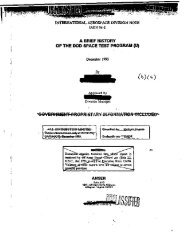LUNAR EXPEDITION PLAN
LUNAR EXPEDITION PLAN
LUNAR EXPEDITION PLAN
You also want an ePaper? Increase the reach of your titles
YUMPU automatically turns print PDFs into web optimized ePapers that Google loves.
A^wt;<br />
4.2.9 MATERIALS<br />
^!C» w<br />
4.2-9-1 the Lunar expedition imposes rigid requirements<br />
on materials to maintain their characteristics vfaile subject to<br />
radiation, vacuum, temperature- extremes, and meteorites. Ibis<br />
problem must be considered by the individual subsystem design.<br />
It is intended to point out here the overall material problem<br />
and programs which will contribute tt>. its solution*<br />
4.2.9.2 The absence of an atmosphere on the moon increases<br />
the radiative flux (particle and electromagnetic) from the sun<br />
and as such potentially Increases the possibility of damage to<br />
man and light-weight plastic structures through the formation<br />
of free radicals and subsequent depolymerization. 5he need for<br />
light-weight shielding is apparent. The vacuum conditions of<br />
the moon would aggrevate the problems associated with moderately<br />
volatile constituents of plastics, lubricants, etc. Tor<br />
instance, the relatively volatile plastlcizers la a plastic<br />
material could evaporate and interfere with the plastic<br />
function. Finally, the results of impact of mlcrcmeteorltes<br />
on structural materials must be determined* All desirable<br />
properties must be acquired without penalty of weight. In<br />
addition to the problems encountered on the Moon, similar<br />
problems are encountered while In transit. In particular the<br />
heating encountered on re-entry into the earth's atmosphere<br />
at 37.000 feet per second presents a severe material problem.<br />
4.2.9.3 Sane of the specific material requirements<br />
that can be identified are:<br />
a. Lubricants that will function for long periods of<br />
time In a vacuum and temperature conditions such as exist In<br />
the moon.<br />
b. Jfaterials that will not sublimate In a vacuum at<br />
moon temperature.<br />
3309P,<br />
f*.<br />
c. Light-weight shielding material against meteorites.<br />
d. light-weight, radiation shielding.<br />
e. Shock-absorbing material that will function at<br />
\ , < -• a<br />
4.32 WDLAR-S-J158<br />
Tail innMl iMlalai InfamBUaa aHactfna «• aatiaaar trtmnm 3^'trft^ VsWwWBJTO. Mnhi *f ffca E(»l*nn*a lam, Tnla<br />
)|, U.S.C (adieu 7V3 ana' 79A, «ka hania-riilM ar matoKa* af wait* m anr •own* ta an vnoaHxriirt BJOM II BreMbtM ht law.<br />
•-- %' --;-• -7T-.-¥-rr<br />
r^- -' •—-:




